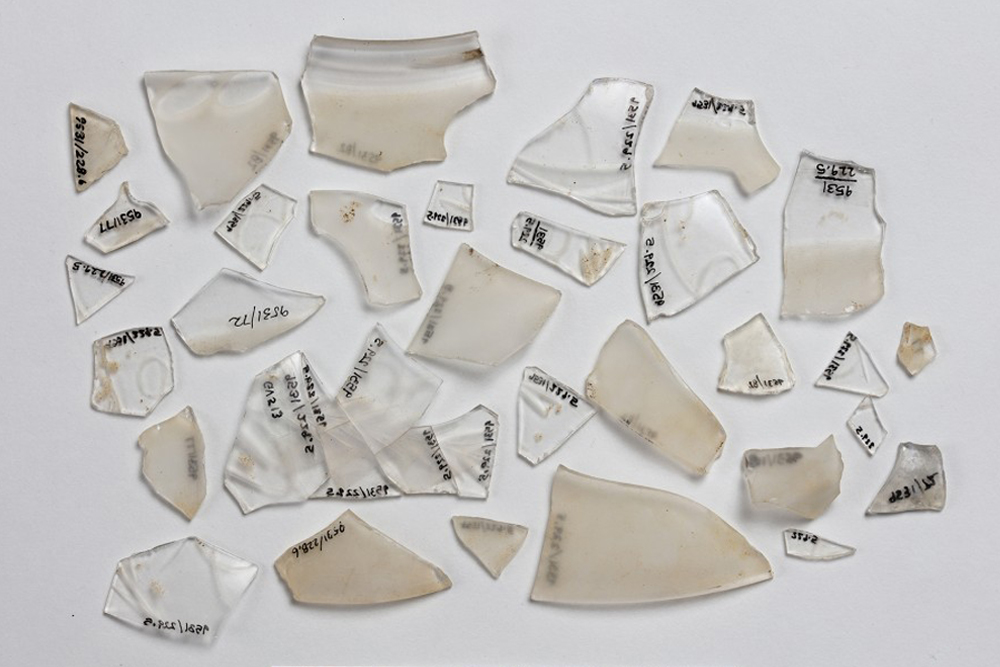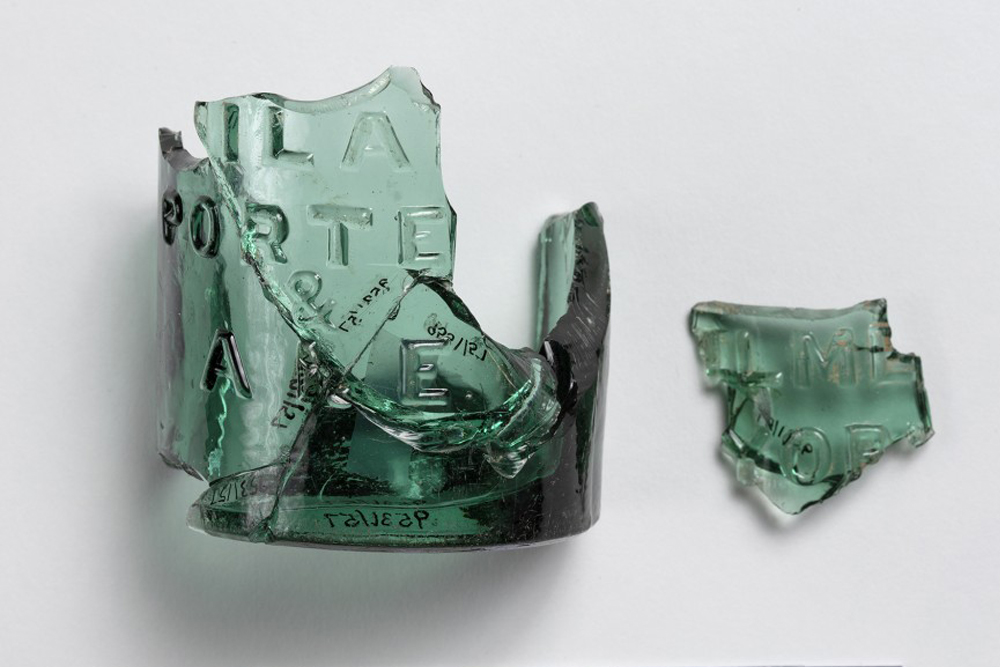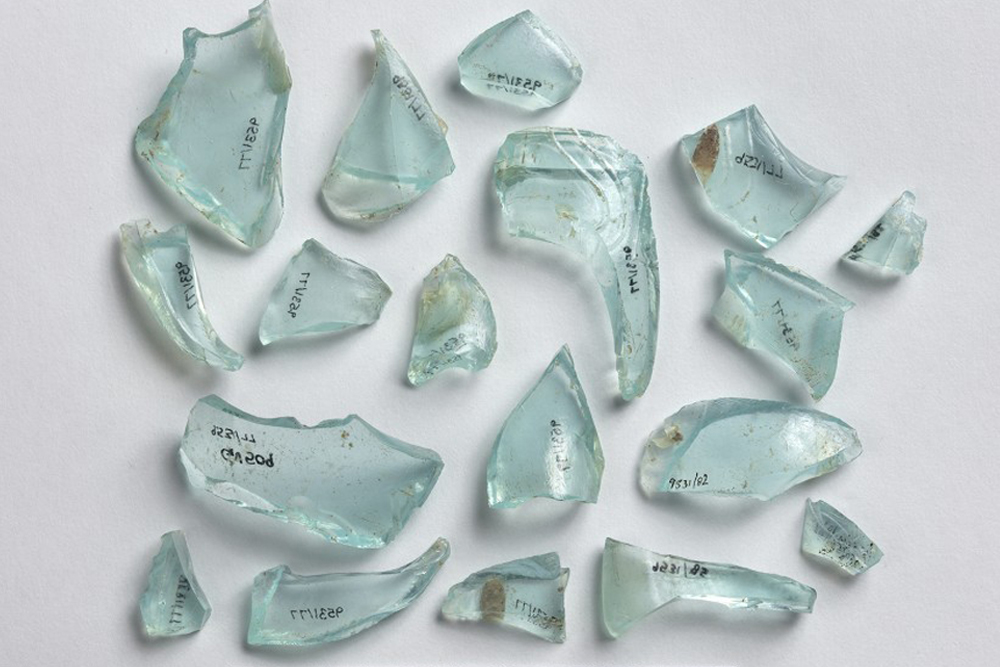Soda bottle
The picture above (Figure 1) shows pieces of glass from a soda bottle found in the Webster and Phillips homes in Seneca Village. Throughout history, soda has been an essential beverage at parties and for leisure time at home. However, in eighteenth century England, soda would be found in apothecary shops and was considered a type of medicine. It was believed to cure fevers, scurvy, and other illnesses, just like a “magic potion.” Richard Bewley created one of the first versions and called this soda “Mephitic Julep.” The name “mephitic” simply meant carbonated at the time, though now it means noxious. In 1781, Thomas Henry made a pamphlet describing mephitic julep and started to produce soda water for public sale on a small scale. He is credited with being the first to advertise soda water. Of course, scientists were already experimenting with carbonated water before Thomas Henry and Richard Bewley (Riley 1958, 3-5).
Making Soda
When making a bottle of soda, the glass bottle and the bottle stopper are as important as the actual soda. Soda bottles were made of “heavy/thick glass in order to withstand the gaseous pressures of the glass itself” (Lindsey 2020). The bottles were cylindrical because this shape is stronger than almost all other shapes (Lindsey 2020). There were also many types of bottle stoppers for these soda bottles. One of the first stoppers used was the cork. Even today, corks are used to seal wine and champagne. The main problem with corks is that they shrink when they dry (Parmalee and Parmalee 1973, 10). Replacements for corks included internal stoppers, screws, etc.
It is then time to carbonate the water. In Thomas Henry’s pamphlet, he describes how to make mephitic julep: the first step is to “dissolve three drams of fossil alkali in each quart of water, and throw in streams of fixed air, till the alkaline taste be destroyed” (Riley 1958). This way of making carbonated water involved mixing in alkali with some water. Another process involved using a machine called the soda fountain, where carbon dioxide is pumped into the water. Since earlier versions of fountains were made of copper, which reacted with the carbonated water and were sometimes sealed with lead, various new soda fountains emerged (Parmalee and Parmalee 1973, 3).
Soda and the Temperance Movement
The soda fountain became an important gathering place for people, especially those who were a part of the temperance movement (Smith 2009, 44). The temperance movement advocated against the consumption of alcoholic beverages, which they considered to be a source of social problems and a large contributor to poverty. Historian Jane Dabel notes that in the highly racist and sexist environment of nineteenth-century New York City, “drinking got some African American women in trouble with the law” and was said to have led to the deaths of many black women. Such tragic outcomes led black reformers to proclaim that “the allurements of the grogshop are more ruinous to the lower class of our color than any other vice”(Dabel 2008, 104). They believed drinking soda was beneficial to their health; because of this, we can make connections to the original purpose of soda water, which was as a type of medicine.

Figure 3: This image shows kids gathering around an outdoor soda fountain in 1898. (Museum of the City of New York).
Soda in Seneca Village
Soda in Seneca Village likely was not used for medicinal purposes. In the yard between the Webster and Phillips houses, archaeologists uncovered only one soda vessel (Wall et al. 2018). This suggests that soda wasn’t something they often bought, since soda was relatively expensive. The average male worker in the nineteenth century only earned a dollar a day, which was the price of a bottle of soda (Linn 2010, 69). Additionally, the Webster and Phillips homes had other bottles that might have been used as medicines, which makes it very unlikely that they used seltzer as medicine. The people of Seneca Village might have started using seltzer as a type of medicine, but it gradually became a beverage for them. Other drinking options would have included lemonade, alcohol, or water. But, as stated before, alcohol was not something that everyone wanted to drink, and lemonade and water might have been too unexciting at times. This made soda the go-to beverage. Of course, most people only drank soda on occasion; for example, the Webster family may have had soda at their children’s birthday parties, and the Phillips newlyweds might have had it at their wedding.
Conclusion
Still, soda could have had other purposes as well in Seneca Village. In the past, Irish immigrants found soda water was emblematic of “health, nostalgia, temperance, Irish nationalism, status, and identity” (Linn 2010, 69). In the same way, soda may been a means for the people of Seneca Village to express their status and identity, because most people in Seneca Village were Black and/or immigrants from other countries. Since soda was so expensive at the time, it was likely a treat that people with less money could occasionally splurge on, likely used for recreational purposes.
Works Cited
Dabel, Jane E. 2008. A Respectable Woman: The Public Roles of African American Women in 19th-Century New York. New York, NY: New York University Press.
Lindsey, Bill. 2020. ”Bottle Typing/ Diagnostic Shapes: Soda and Mineral Water Bottles.” Society for Historical Archaeology and Bureau of Land Management. https://sha.org/bottle/soda.htm.
Linn, Meredith B. 2010. “Elixir of Emigration: Soda Water and the Making of Irish-Americans in Nineteenth-Century New York City.” Historical Archaeology 44, no 4: 69-109.
New York City Archaeological Repository: The Nan A. Rothschild Research Center. 2020. “Seneca Village.” NYC Landmarks Preservation Commission, New York, NY. http://archaeology.cityofnewyork.us/collection/map/seneca-village.
Paul, John R., and Paul W. Parmalee. 1973. Soft Drink Bottling: A History with Special Reference to Illinois. Springfield, IL: Illinois State Museum Society.
Riley, John J. 1958. A History of the American Soft Drink Industry: Bottled Carbonated Beverages 1807-1957. Washington, D.C.: American Bottlers of Carbonated Beverages.
Smith, Andrew F. 2009. “The Food and Drink of New York from 1624 to 1898.” In Gastropolis: Food and New York City, edited by Annie Hauck-Lawson and Jonathan Deutsch. New York, NY: Columbia University Press.
Wall, Diana diZerega, Nan A. Rothschild, Meredith B. Linn, and Cynthia R. Copeland. 2018. “Seneca Village, A Forgotten Community: Report on the 2011 Excavations.” New York, NY: Institute for the Exploration of Seneca Village History, Inc. A report submitted to NYC Landmarks Preservation Commission, the Central Park Conservancy, and the NYC Department of Parks and Recreation.






